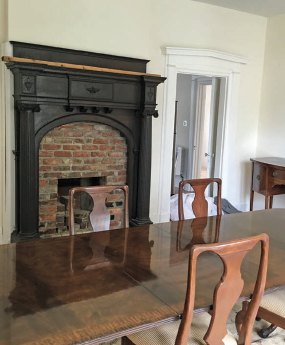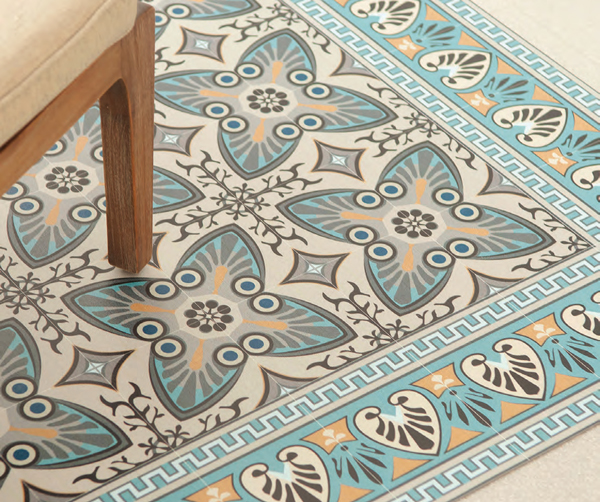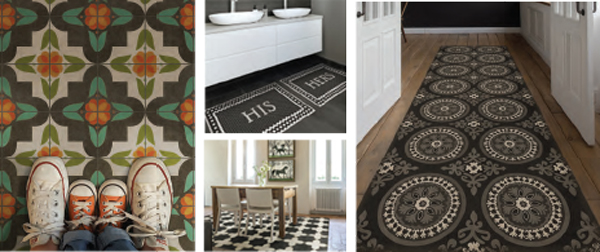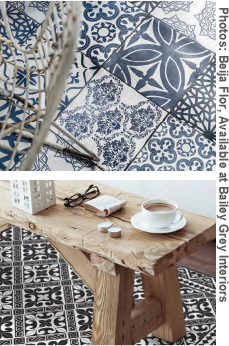Walkable Art | Vinyl Floorcloths


What once was old is new again. With a rich history of adorning floors in the south, vinyl floorcloths are making a comeback. More casual, durable and easily maintained than rugs, vinyl floorcloths protect floors from grime and wear, while dressing up spaces with versatile design options that can be vintage, modern or whimsical.
Floorcloths are popular today even with buyers who aren’t tethered to history. Because any pattern that you can imagine is possible, creative design freedom is truly within reach, with product designs that feel personal rather than mass-produced. Since every inch is hand-made by an artist, the addition of a floorcloth to your spaces sums to art, geometry, and history combined.
Floorcloths are about as vintage as you can get for a good reason—they are wonderfully durable and lie flat on the floor; these classics are easy to clean and bring a burst of color and fun to any space. Non-slip vinyl floor cloths are perfect for kitchens, dining areas and laundry rooms.

Historic treads
Though elemental in early American design heritage, the textile tradition of painting canvas floorcloths originated in France in the 1400s. These early pieces were small and generally used on tabletops as decoration, considered too precious to place on the floor. In the 1700s, American colonists took the idea one step further and transformed old ship sails into floorcloths. The cloths proved to be an inherently great product—they were durable and stood up to insects, heavy foot traffic and muddy boots. Floorcloths were also easy to clean and helped to control the interior climate by blocking out cold drafts in winter and staying cool underfoot in summer. Floorcloths were used in every area of Colonial homes—in entryways, under dining tables, in kitchens and bedrooms.
Originally, floorcloths were designed to resemble imported woven rugs and expensive marble and 11a7acparquet floors. Primarily imported from England and usually with just one color, early cloths were produced using stencils; eventually, the palette grew to include chrome, blue, black, vermilion and malachite green. Floorcloths used a common material of the era—sturdy woven cotton—to address an equally common problem—protection and adornment of bare wood floors. The design staple had extra appeal in the sweltering South, where floorcloths often replaced heavy wool rugs in summer and were used as insulation under carpets in colder months.
President Thomas Jefferson had at least two floorcloths—one in the great hall at Monticello and another in a small dining room—in his words, “to secure a very handsome floor from grease and the scouring that it necessitates.” George Washington had a cloth at Mount Vernon, and John Adams listed floorcloths in his exit inventory when he left the White House. These original, historic floorcloths are rare—literally worn to pieces; only fragments remain to be found, primarily in museums. The Golden Age of the American floorcloth spanned the late 1700s through the mid-1800s; when Sir Frederick Walton invented cheaper, mass-produced and easily available linoleum in the 1850s, it cornered the market.
The process of creating an old-style floorcloth in modern times is not lost; each is a work of art. Each floorcloth begins with stretching cotton duck—the tightly woven canvas used in awnings and theater sets—on a simple wooden frame. The canvas is sealed and stiffened with six coats of exterior-grade latex. Period floorcloths used linseed oil mixed with pigments and turpentine, but weren’t as durable and adept at handling high traffic and humidity as modern products. Nevertheless, the traditional art form survives. After a light sanding, an artist hand paints and employs custom stencils to apply artwork; Greek keys, compass roses, and faux marbling are mainstays. Finally, three coats of clear acrylic and a top layer of bowling alley wax make the one-of-a-kind floor art resistant to cracking, warping, and rolling.
Walk on the wild side
If you’re a do-it-yourselfer, you might want to make your own floorcloth; consider buying a remnant of vinyl flooring and painting your design on the underside. Remnants are easy to cut to size, extremely affordable and have no need of special edge treatment. It’s a fun process, but the tricky part can be coming up with an original design. A few hints: keep it simple or free-form; use two colors or multiple hues. Above all, make the process an expression of your creativity. Any good acrylic paint will work for your design, but don’t forget to protect your work of art with a couple of coats of Trewax once you’ve finished. Most purchased floorcloths come with a skid-proof backing already applied. If you are making your own, use clear silicone painted around the backside edges to keep your floorcloth from slipping.
Everything old is new again

Miriam Riggs is an area artisan who recently created three traditional floorcloths for the bedchambers at Point of Honor in Lynchburg. A veteran of her craft, Riggs has been making floorcloths for 35 years now, many of them custom designed for historic interiors. For her inspiration at Point of Honor, Riggs looked to laurel wreaths on the carved mantle detail as well as colors and styling from the custom wallpaper found in the house. Riggs explains, “In historic houses such as Point of Honor, I always seek to make the floorcloth based on historically appropriate designs and colors, while also adapting the design to the interior decoration currently in use.”
Miriam Riggs doesn’t just create historical floorcloths. She also makes modern custom designs based on her clients’ specifications; those floorcloths can be very personal. In her words, “I see my custom designs often as an extension of the client’s imagination. I can help them visualize a concept, and turn it into a functional piece of ‘walkable art.’”
Interior designer, Moyanne Harding, is a great fan of new floorcloth styles, preparations and products available, and is especially fond of using them in kitchens, mudrooms, and laundry rooms. In her words, they belong, “Anywhere kids, animals or husbands might bring in dirt.” She says floorcloths have come back en vogue due to their availability in a variety of sizes, patterns and colors. Further, because of their thin profile, modern vinyl pieces present no trip hazards. In her design studio, she showcases samples from a number of lines; pieces can be ordered outright or custom-made, with pricing typically from $20 to $40 per square foot. A leader in the vinyl floorcloth design space, Spicher and Company of Carlisle, Pennsylvania has a fantastic line of vintage-inspired vinyl floorcloths designed by Kolene Spicher.
Another line of vinyl floorcloths; Beija Flor specializes in traditional designs recreated in a contemporary medium; their floorcloths are produced from high quality, layered vinyl sheets. These beautiful pieces are strong, flexible and movable; they are made partly from recycled materials and finished with finely printed designs using a sand embossing technique. ✦
"Walkable Art", design, dining areas, hand-made, KITCHENS, laundry rooms, marble, modern, painting canvas, parquet, ship sails, te, tile, vintage, Vinyl Floorcloths, whimsical, work of art






